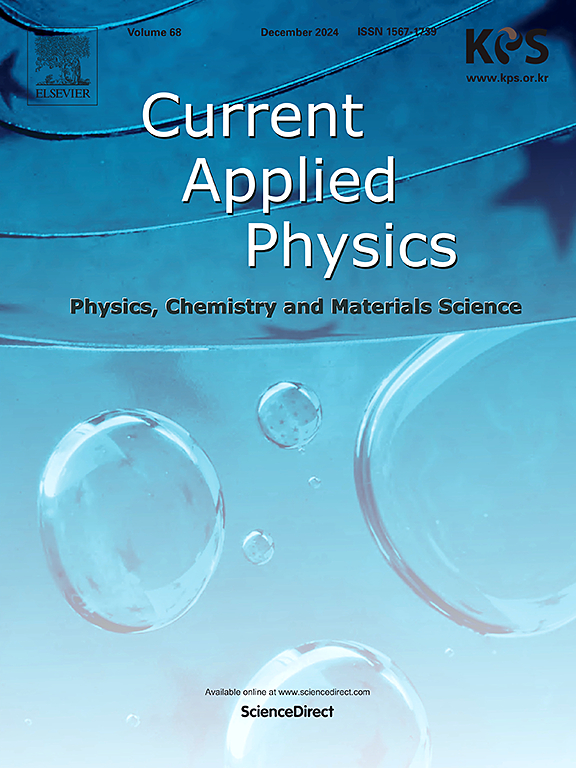Effect of heat-affected zone on the nanosecond pulsed laser scanning ablation of Ag nanoparticle layer
IF 2.4
4区 物理与天体物理
Q3 MATERIALS SCIENCE, MULTIDISCIPLINARY
引用次数: 0
Abstract
Pulsed laser ablation can be used in printed electronics to remove silver (Ag) nanoparticle (NP) inks from undesired locations. Removing Ag NP involves a scanning ablation process, in which laser beams are irradiated on spots irradiated by a previous laser beam. In this study, that the heat-affected zone (HAZ), which is the peripheral area of the ablation crater where NPs are not ablated but are affected by heat, greatly influences the ablation aspects. Ablation failure was observed in short laser beam displacements, where the irradiated laser energy per unit length increased. Additional experimental investigation and thermal analysis concluded that property variations, such as increased reflectivity and thermal conductivity, suppressed the temperature increase and made it more difficult for the HAZ and nearby Ag NP to be ablated. Moreover, the ablated lines formed by a higher laser beam fluence and shorter laser beam displacement were not as ablated as the lines formed with a relatively lower laser beam fluence and longer laser beam displacement. Through detailed analysis, we deduced that the local fluence of the second laser beam irradiated on the HAZ was a more critical parameter than the peak fluence of the laser beam. We suggest that in the case of a Gaussian laser beam, the laser beam displacement should be equal to the radius of the ablation crater and HAZ to maximize the local fluence irradiated on the HAZ and minimize the adverse effects of the HAZ. The results can provide a guideline for future manufacturers to perform Ag NP layer ablation while considering the influence of the HAZ.

热影响区对纳秒脉冲激光扫描烧蚀银纳米颗粒层的影响
脉冲激光烧蚀可用于印刷电子去除银(Ag)纳米颗粒(NP)油墨从不需要的位置。去除银NP涉及扫描烧蚀过程,其中激光束照射在先前激光束照射过的斑点上。在本研究中,热影响区(HAZ)是烧蚀坑的外围区域,NPs未被烧蚀,但受热影响,对烧蚀方面影响很大。在较短的激光束位移中观察到烧蚀失效,单位长度的辐照激光能量增加。进一步的实验研究和热分析得出结论,反射率和导热系数的增加等性质变化抑制了温度的升高,使热影响区和附近的Ag NP更难被烧蚀。较高的激光束能量和较短的激光束位移所形成的烧蚀线不如较低的激光束能量和较长的激光束位移所形成的烧蚀线。通过详细的分析,我们推断出第二束照射在热影响区上的局部能量比激光束的峰值能量更重要。我们建议,在高斯激光束的情况下,激光束的位移应等于烧蚀坑和热区半径,以最大限度地提高辐射对热区的局部影响,最大限度地减少热区的不利影响。研究结果可为今后在考虑热影响的情况下进行银NP层烧蚀提供指导。
本文章由计算机程序翻译,如有差异,请以英文原文为准。
求助全文
约1分钟内获得全文
求助全文
来源期刊

Current Applied Physics
物理-材料科学:综合
CiteScore
4.80
自引率
0.00%
发文量
213
审稿时长
33 days
期刊介绍:
Current Applied Physics (Curr. Appl. Phys.) is a monthly published international journal covering all the fields of applied science investigating the physics of the advanced materials for future applications.
Other areas covered: Experimental and theoretical aspects of advanced materials and devices dealing with synthesis or structural chemistry, physical and electronic properties, photonics, engineering applications, and uniquely pertinent measurement or analytical techniques.
Current Applied Physics, published since 2001, covers physics, chemistry and materials science, including bio-materials, with their engineering aspects. It is a truly interdisciplinary journal opening a forum for scientists of all related fields, a unique point of the journal discriminating it from other worldwide and/or Pacific Rim applied physics journals.
Regular research papers, letters and review articles with contents meeting the scope of the journal will be considered for publication after peer review.
The Journal is owned by the Korean Physical Society.
 求助内容:
求助内容: 应助结果提醒方式:
应助结果提醒方式:


